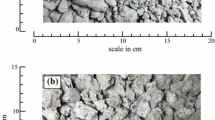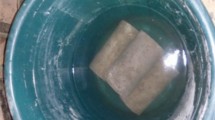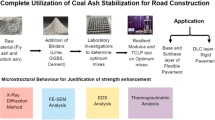Abstract
Use of by-product materials, such as steel slag and cathode ray tube glass, as alternative recycled materials in the construction of roads, could reduce the demand for natural aggregates. Measurements of the physical properties (specific gravity, water absorption, Los Angeles abrasion value and soundness) and microstructure characteristics were made to evaluate the effectiveness of using these materials in pavement road base. The laboratory assessments were also conducted using California bearing ratio, unconfined compression strength and indirect tensile strength tests. Leaching tests were performed on six elements (arsenic, barium, cadmium, lead, silver and mercury) to determine the leaching potential of hazardous metals. Element concentration release limits were determined based on the Toxicity Characteristic Leaching Procedure (TCLP). The results indicate that the alternative recycled materials are suitable for use in aggregates and meet the requirements for natural aggregates used for similar purposes. Microstructure analysis shows that the steel slag is more porous and rougher than granite and cathode ray tube glass. The higher percentage of steel slag produces higher California bearing ratio test values for both the soaked and unsoaked samples. Findings from unconfined compression strength and indirect tensile strength tests show that the performance of the mixture was enhanced significantly upon incorporating a higher percentage of steel slag. The samples show a significant strength improvement between 2 and 17%. The concentration of leached barium and lead is higher than that of the other elements, however it is still less than 1% of the TCLP regulatory limit, hence the concentration of the leached elements does not pose an environmental risk. The laboratory test results indicate that mixtures consisting of granite, steel slag and cathode ray tube glass are both environmentally safe and suitable for use as aggregate in pavement road base.
Graphic abstract








Similar content being viewed by others
References
Abah J, Mashebe P, Onjefu SA (2014) Survey of the levels of some heavy metals in roadside dusts along katima mulilo urban road construction. Namibia Am J Environ Prot 3:19
Alissa EM, Ferns GA (2011) Heavy metal poisoning and cardiovascular disease. J Toxicol 2:1–21
Arulrajah A, Ali MMY, Disfani MM, Piratheepan J, Bo MW (2013) Geotechnical performance of recycled glass-waste rock blends in footpath bases. J Mater Civ Eng 25:653–661
Arulrajah A, Disfani MM, Horpibulsuk S, Suksiripattanapon C, Prongmanee N (2014) Physical properties and shear strength responses of recycled construction and demolition materials in unbound pavement base/subbase applications. Constr Build Mater 58:245–257
ASTM C127 (2007) Standard test method for density, relative density (specific gravity), and absorption of coarse aggregate. Annual Book of ASTM Standards, Vol 04.02, ASTM International
ASTM C128 (2007a) Standard test method for density, relative density (specific gravity), and absorption of fine aggregate. Annual Book of ASTM Standards, Vol 04.02, ASTM International
ASTM C88 (2005) Standard test method for soundness of aggregates by use of sodium sulfate or magnesium sulfate. Annual Book of ASTM Standards, Vol 04.02, ASTM International
ASTM C131 (2006) Standard test method for resistance to degradation of small-size coarse aggregate by abrasion and impact in the Los Angeles machine. Annual Book of ASTM Standards, Vol 04.02, ASTM International
ASTM D6931 (2012) Standard test method for indirect tensile (IDT) strength of bituminous mixtures, ASTM International
ASTM D1633 (2000) Standard test methods for compressive strength of molded soil-cement cylinders. ASTM International
Awazhar NA, Khairuddin FH, Rahmad S, Fadzil SM, Omar HA, Nur NI, Badri KH (2020) Engineering and leaching properties of asphalt binders modified with polyurethane and cecabase additives for warm-mix asphalt application. Constr Build Mater 238:117699
Ayan V, Limbachiya MC, Omer JR, Masoud S, Azadani N (2014) Compaction assessment of recycled aggregates for use in unbound subbase application. J Civ Eng Manag 20:169–174
Aziz MMA, Hainin MR, Yaacob H, Ali Z, Chang FL, Adnan AM (2014) Characterisation and utilisation of steel slag for the construction of roads and highways. Mater Res Innov 18:255–259
BS 1377 (1990) Methods of test for soils for civil engineering purposes–part 4: compaction-related tests. British Standard, BSI
Chiban M, Zerbet M, Carja G, Sinan F (2012) Application of low-cost adsorbents for arsenic removal: a review. J Environ Chem Ecotoxicol 4:91–102
Galvín AP, Ayuso J, Agrela F, Barbudo A, Jiménez JR (2013) Analysis of leaching procedures for environmental risk assessment of recycled aggregate use in unpaved roads. Constr Build Mate 40:1207–1214
Guo J, Bao Y, Wang M (2018) Steel slag in China: treatment, recycling, and management. Waste Manag 78:318–330
Hainin MR, Aziz MM, Ali Z, Putra Jaya R, El-Sergany MM, Yaacob H (2015) Steel slag as a road construction material. J Teknol 73:33–38
Jaibee S, Abd Rahim AK, Mohamad F, Jamia S, Kiong SC, Seiji Y, Muhd Nor NH (2015) Review on current status of waste electric and electronic product in Malaysia. Appl Mech Mater 5:773–774
Jeffry SNA, Jaya RP, Abdul Hassan N, Yaacob H, Satar MKIM (2018) Mechanical performance of asphalt mixture containing nano-charcoal coconut shell ash. Constr Build Mater 173:40–48
Jiang Y, Ling TC, Shi C, Pan SY (2018) Characteristics of steel slags and their use in cement and concrete: a review. Resour Conserv Recycl 136:187–197
JKR (2008) Standard specification for road works (JKR/SPJ/2008) section 4: flexible pavement
Kosior-Kazberuk M, Grzywa M (2014) Recycled aggregate concrete as material for reinforced concrete structures. J Sustain Archit Civ Eng 7:60–66
Law DW, Evans J (2013) Effect of leaching on ph of surrounding water. ACI Mater J 110:291–296
Ling TC, Poon CS (2014) Use of recycled CRT funnel glass as fine aggregate in dry-mixed concrete paving blocks. J Clean Prod 68:209–215
Maghool F, Arulrajah A, Du YJ, Horpibulsuk S, Chinkulkijniwat A (2017) Environmental impacts of utilizing waste steel slag aggregates as recycled road construction materials. Clean Technol Environ Policy 19:949–958
Mohamad AY, Jamil M, Md Yusoff NI, Taha MR, Karim MR, Fadzil SM (2020) Feasibility study of utilizing steel slag and cathode ray tube glass as aggregate replacement for road base. Int J Nanoelectron Mater 13:129–136
Mohd Fadzil S, Sarmani S, Majid AA, Khoo KS, Hamzah A (2011) K 0-INAA measurement of levels of toxic elements in oil sludge and their leachability. J Radioanal Nucl Chem 287:41–47
Mombelli D, Mapelli C, Barella S, Di Cecca C, Le Saout G, Garcia-Diaz E (2016) The effect of chemical composition on the leaching behaviour of electric arc furnace (EAF) carbon steel slag during a standard leaching test. J Environ Chem Eng 4:1050–1060
Nnorom IC, Osibanjo O, Ogwuegbu MOC (2011) Global disposal strategies for waste cathode ray tubes. Resour Conserv Recycl 55:275–290
Oluwasola EA, Hainin MR, Aziz MMA, Warid MNM (2016) Volumetric properties and leaching effect of asphalt mixes with electric arc furnace steel slag and copper mine tailings. Sains Malaysiana 45:279–287
Pasetto M, Baldo N (2016) Recycling of waste aggregate in cement bound mixtures for road pavement bases and sub-bases. Constr Build Mater 108:112–118
Pauzi NNM, Jamil M, Hamid R, Abdin AZ, Zain MFM (2019) Influence of spherical and crushed waste Cathode-Ray Tube (CRT) glass on lead (Pb) leaching and mechanical properties of concrete. J Build Eng 21:421–428
Qasrawi H (2012) Use of relatively high Fe2O3 steel slag as coarse aggregate in concrete. ACI Mater J 109:471–478
Romero D, James J, Mora R, Hays CD (2013) Study on the mechanical and environmental properties of concrete containing cathode ray tube glass aggregate. Waste Manag 33:1659–1666
Sas W, Głuchowski A, Radziemska M, Dziecioł J, Szymański A (2015) Environmental and geotechnical assessment of the steel slags as a material for road structure. Materials 8:4857–4875
Somasundaram S, Jeon TW, Kang YY, Kim WIL, Jeong SK, Kim YJ, Yeon JM, Shin SK (2015) Characterization of wastes from construction and demolition sector. Environ Monit Assess, p 187
Tapio S, Grosche B (2006) Arsenic in the aetiology of cancer. Mutat Res 612:215–246
Yu-Gong TXM, Wu YF, Zhe-Tan L-L (2016) Recent development of recycling lead from scrap CRTs: a technological review. Waste Manag 57:176–186
Yüksel İ (2017) A review of steel slag usage in construction industry for sustainable development. Environ Dev Sustain 19:369–384
Acknowledgements
The authors express gratitude to Universiti Kebangsaan Malaysia (UKM) for providing financial assistance in the form of a research grant scheme (FRGS/1/2020/STG05/UKM/02/4) which made this study possible.
Author information
Authors and Affiliations
Corresponding author
Ethics declarations
Conflict of interest
They are no known competing financial interests or personal relationships that could have appeared to influence the work reported in this paper.
Additional information
Publisher's Note
Springer Nature remains neutral with regard to jurisdictional claims in published maps and institutional affiliations.
Rights and permissions
About this article
Cite this article
Mohamad, A.Y., Jamil, M., Md Yusoff, N.I. et al. Physical, microstructure and leaching assessments for pavement road base containing mixed steel slag and cathode ray tube glass. Clean Techn Environ Policy 24, 919–930 (2022). https://doi.org/10.1007/s10098-021-02231-8
Received:
Accepted:
Published:
Issue Date:
DOI: https://doi.org/10.1007/s10098-021-02231-8




